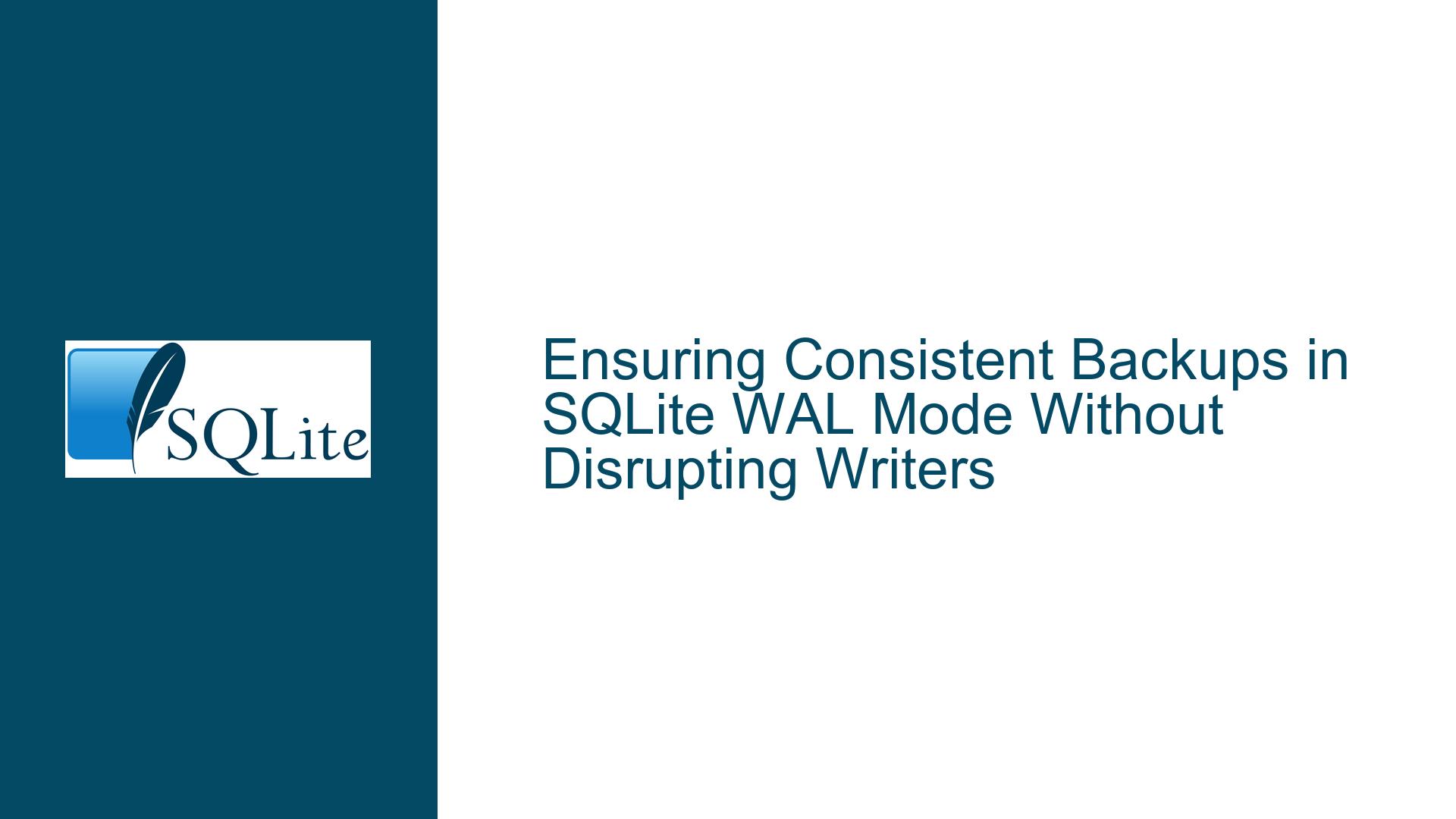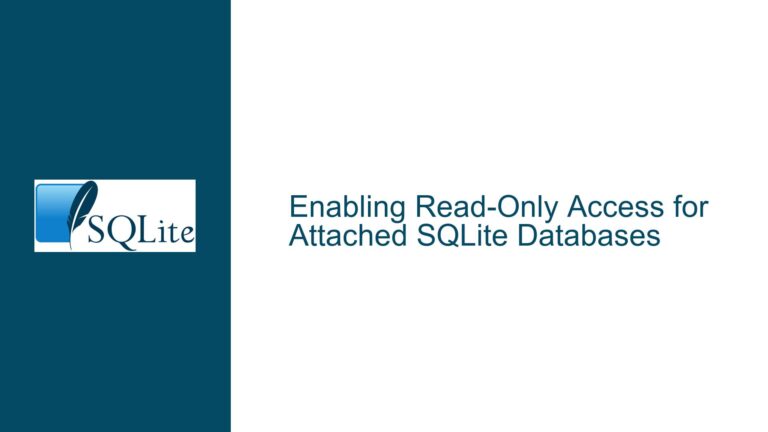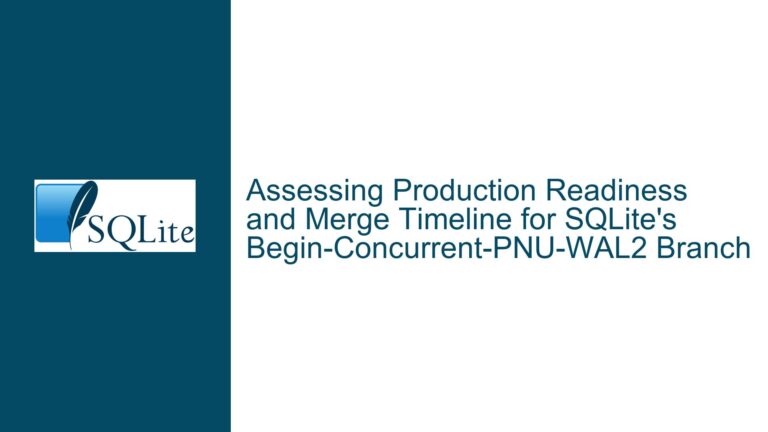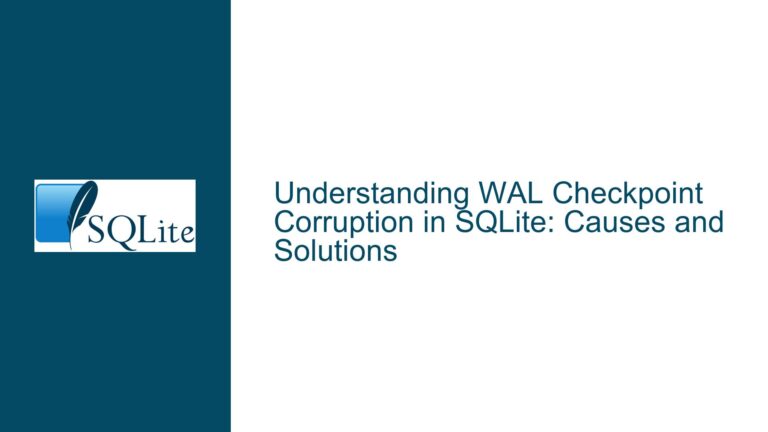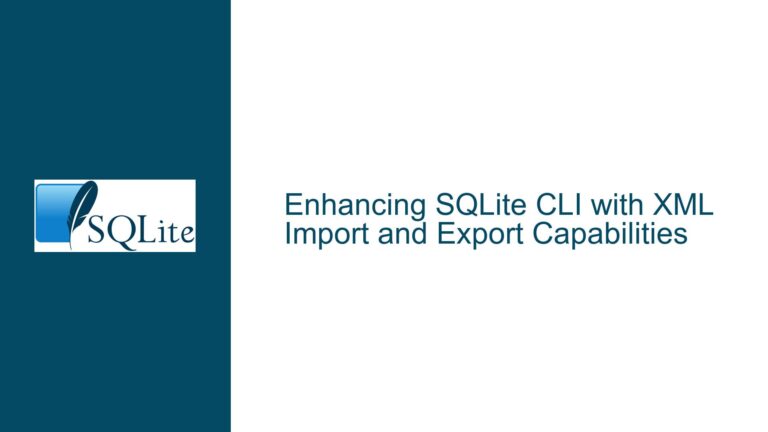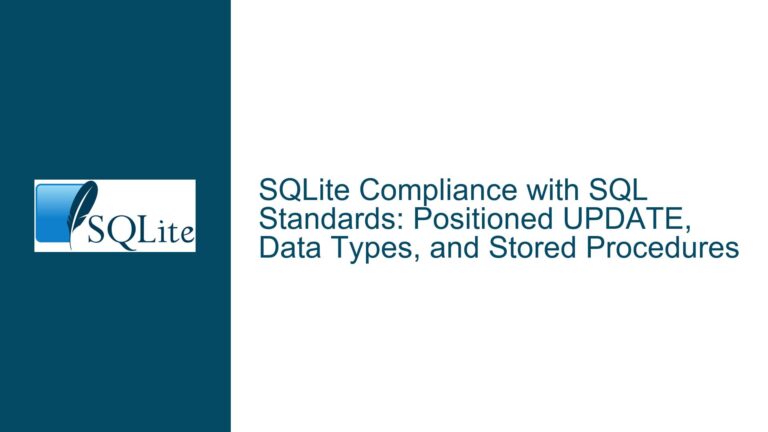Ensuring Consistent Backups in SQLite WAL Mode Without Disrupting Writers
Understanding WAL Mode Behavior During Concurrent File Access and Backup Operations
WAL Architecture and Backup Challenges in Logging Applications
SQLite’s Write-Ahead Logging (WAL) mode fundamentally changes how transactions are committed compared to traditional rollback journal modes. In WAL mode, new database changes are appended to a separate WAL file (*-wal) instead of overwriting pages in the main database file. A checkpoint operation periodically transfers these changes from the WAL file to the main database file. This architecture enables concurrent reads and writes but introduces critical considerations for backup operations – especially when third-party tools copy database files without awareness of SQLite’s internal state.
The core challenge arises from the database’s distributed state: live data exists in two interdependent files (main .db and .wal) that must remain synchronized. When external processes copy the main database file without the accompanying WAL file or during an active checkpoint, the backup becomes inconsistent. This manifests as either:
- A main database file containing outdated pages (if copied before checkpoint completion)
- A WAL file with committed transactions that reference non-existent pages in the main file (if copied after partial checkpointing)
- Corrupted index structures due to mismatched page versions between files
These issues are exacerbated in logging systems where:
- Continuous writes occur with periodic purge operations via triggers
- Checkpoint timing is unpredictable due to automatic checkpoint thresholds
- Backup windows are narrow and cannot guarantee quiescent states
Critical Failure Modes When Copying Live WAL-Mode Databases
1. Asynchronous File State Capture
The WAL file contains uncheckpointed changes that haven’t been written to the main database file. A filesystem copy operation that grabs the main .db file without the corresponding .wal file creates a backup missing recent transactions. Conversely, copying both files at different moments (e.g., main file first, then WAL) introduces temporal mismatches where WAL entries reference non-existent database pages.
2. Checkpoint Interference During Backup
Automatic checkpoints triggered by WAL size thresholds (default 1000 pages) may collide with backup operations. If a checkpoint begins during file copying:
- The main database file undergoes partial page updates
- WAL file truncation may leave committed transactions in limbo
- Backup tools may capture intermediate states with split-page writes
3. Trigger-Based Maintenance Conflicts
Housekeeping triggers that DELETE old records interact with WAL’s append-only design. When a purge operation executes:
- DELETE statements mark pages as free in the database file
- WAL entries continue appending new changes
- Checkpointing must reconcile freed pages with active WAL entries
Concurrent backup operations during this reconciliation may capture:
- Partially vacuumed database pages
- WAL entries referencing already-purged records
- Inconsistent free-page maps
4. VFS Layer Assumptions
SQLite’s Virtual File System layer assumes exclusive access to database files in WAL mode. Third-party copy tools bypassing SQLite’s APIs violate this assumption, leading to:
- Locking conflicts if the OS allows shared file handles
- CRC validation failures due to torn writes
- SHM file mismatches if the shared-memory file (-shm) is modified during backup
Robust Backup Strategies for WAL-Mode Logging Databases
1. Leverage SQLite’s Online Backup API
The sqlite3_backup interface provides transactionally consistent snapshots without blocking writers:
// C API Example
sqlite3 *src = open_source_db();
sqlite3 *dst = open_backup_db();
sqlite3_backup *bkp = sqlite3_backup_init(dst, "main", src, "main");
if(bkp){
do{
rc = sqlite3_backup_step(bkp, 5); // Copy 5 pages per step
if(rc==SQLITE_OK || rc==SQLITE_BUSY || rc==SQLITE_LOCKED){
sqlite3_sleep(250); // Throttle backup rate
}
} while(rc==SQLITE_OK || rc==SQLITE_BUSY || rc==SQLITE_LOCKED);
sqlite3_backup_finish(bkp);
}
Advantages:
- Operates at the SQLite level, respecting all locks and transactions
- Creates a consistent snapshot even during continuous writes
- Allows incremental progress with minimal writer disruption
Implementation Notes:
- Use
SQLITE_LIMIT_ATTACHEDto manage concurrent backup connections - Set
sqlite3_busy_timeout()to handle lock contention gracefully - Monitor
sqlite3_backup_remaining()andsqlite3_backup_pagecount()for progress
2. Scheduled Checkpoint Coordination
For systems where backup timing can be controlled:
-- Manual checkpoint before backup
PRAGMA wal_checkpoint(TRUNCATE);
Workflow:
- Pause new transaction starts
- Execute blocking checkpoint to merge WAL into main DB
- Copy main .db file (now contains all committed data)
- Resume normal operations
Tradeoffs:
- Introduces write latency during checkpoint
- Requires application-level coordination
- Loses uncheckpointed WAL entries if used alone
Enhanced Approach:
Combine with WAL file backup:
# After checkpoint
cp main.db backup.db
cp main-wal backup-wal
Ensures captured WAL contains only post-checkpoint changes.
3. VACUUM INTO for Snapshot Isolation
The VACUUM INTO command (SQLite 3.27+) creates transactionally consistent copies:
VACUUM INTO '/path/to/backup-$(date +%s).db';
Characteristics:
- Executes as a single transaction
- Creates a fully self-contained database file
- Avoids filesystem-level race conditions
Optimization Strategies:
- Use named key files to trigger backups on-demand
- Pair with
PRAGMA journal_mode=DELETEduring vacuum for smaller outputs - Automate backup rotation based on timestamped filenames
4. Filesystem Snapshot Coordination
For systems with COW (Copy-on-Write) filesystems like ZFS or Btrfs:
- Freeze database writes using
sqlite3_db_cacheflush() - Create atomic filesystem snapshot
- Thaw database writes
- Copy from snapshot rather than live files
Requirements:
- Filesystem support for instantaneous snapshots
- Coordination between SQLite and volume manager
- Short freeze windows to minimize write stalls
5. WAL Size Management and Checkpoint Tuning
Prevent WAL overgrowth and unpredictable checkpointing:
-- Reduce automatic checkpoint threshold
PRAGMA wal_autocheckpoint = 500; -- Pages instead of default 1000
-- Enable incremental checkpointing
PRAGMA wal_autocheckpoint = 0; -- Disable auto-checkpoint
-- Then call periodically:
PRAGMA wal_checkpoint(PASSIVE);
Monitoring Techniques:
- Track WAL size growth rate:
SELECT page_count FROM pragma_wal_checkpoint; - Alert when WAL exceeds safe thresholds
- Schedule aggressive checkpoints during low activity
6. Application-Controlled Backup Signaling
Implement a cooperative backup protocol:
- Backup tool creates a "request" file in a watched directory
- Application detects request file
- Application completes current transaction
- Application initiates
VACUUM INTOor API backup - Application signals completion with "ready" file
- Backup tool copies the generated backup file
- Cleanup signals and temporary files
Advantages:
- No external process management required
- Integrates with existing application logic
- Allows for pre-backup flushing and post-backup validation
7. Hybrid Journal Mode Strategies
Use different journal modes for operational vs backup phases:
-- During normal operation
PRAGMA journal_mode=WAL;
-- During backup window
PRAGMA journal_mode=DELETE;
VACUUM;
PRAGMA journal_mode=WAL;
Considerations:
- Introduces mode transition overhead
- Requires quiescent periods for mode changes
- May complicate recovery scenarios
8. Delta Backup Architectures
Instead of full database copies, log WAL files incrementally:
- Copy closed WAL segments after checkpoint rotation
- Reconstruct historical states from WAL chain
- Combine with periodic full backups
Implementation Requirements:
- Custom WAL archival process
- Precise checkpoint coordination
- Version-aware restoration tools
9. Connection-Level Isolation
For single-threaded applications:
// Serialize backup and write operations
sqlite3_exec(db, "BEGIN IMMEDIATE", 0, 0, 0);
// Perform backup operation
sqlite3_exec(db, "COMMIT", 0, 0, 0);
Guarantees:
- Exclusive access during backup window
- Atomic transition between operational states
- Simplified concurrency management
10. Validation and Repair Protocols
Implement post-backup integrity checks:
-- On backup file
PRAGMA integrity_check;
PRAGMA quick_check;
Automation Steps:
- Checksum backup files after transfer
- Verify SQLite header validity
- Test partial restores in sandbox environment
Each strategy addresses specific failure modes while balancing performance, consistency, and complexity. The optimal approach depends on write intensity, backup frequency, and availability requirements. For most logging applications, combining VACUUM INTO with application-coordinated checkpoints provides robust consistency without sacrificing WAL’s write performance benefits.
